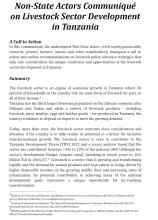Land Library
Welcome to the Land Portal Library. Explore our vast collection of open-access resources (over 74,000) including reports, journal articles, research papers, peer-reviewed publications, legal documents, videos and much more.
/ library resources
Showing items 1 through 9 of 22.In this communiqué, the undersigned Non-State Actors (civil society,pastoralist, research, private, farmers’ unions and other stakeholders) champion a call to action and outline recommendations on livestock policy advocacy strategies that take into consideration the unique conditions and opportun
This paper provides an overview of what we know about farm size distributions, the emerging land markets, the role of tenure systems, tenure reforms and land policies in shaping the distribution of increasingly scarce land resources.
This report springs from series of field visits.Its aim was, among others, to examine further the extent of human rights violations suffered by pastoralists in Kilombero and Rufiji valley during the evictions.
CAADP Policy Brief 10by Kate Wellard-Dyer
This article provides a review of the past and potential future roles of land tenure reforms and land markets in Sub-Saharan Africa (SSA) as responses to population growth in the process of land use intensification and livelihood transformation.
The primary aim of this study is to investigate the size of the range lost to other forms of land uses. This will support the argument that it is time to reconsider the pastoralists sector as a legitimate mode of production in the country which, like other sectors, deserve due priority.
The cities in southern Africa reflect the rapid urbanisation characteristic of sub-Saharan Africa in general.
The cities in the East African region are characterised by rapid urbanisation and uncontrolled spatial sprawl, with large informal settlements and inadequate service provision.
This report discusses the potential benefits of, and the current challenges for, agricultural land investment in Tanzania and Mozambique. The paper finds that there is little, if any, development potential in these investments.




